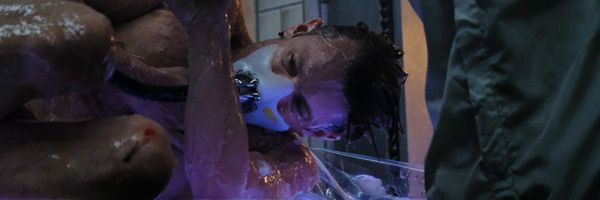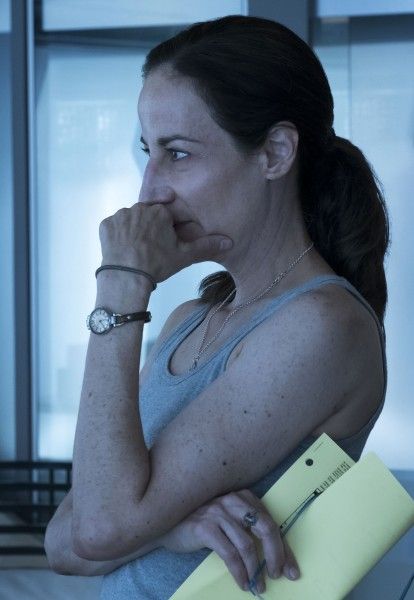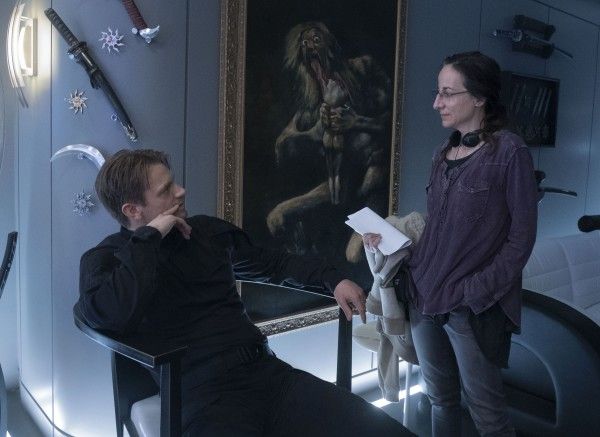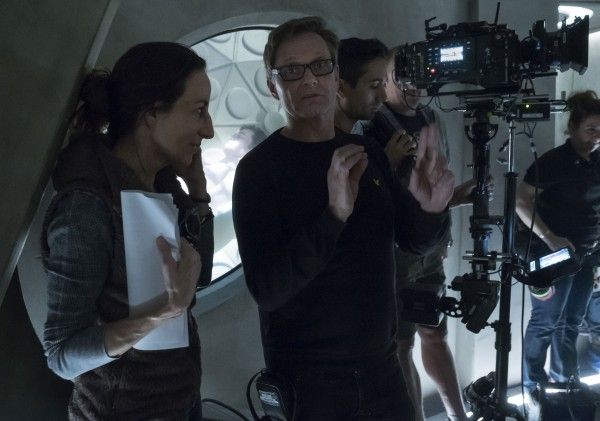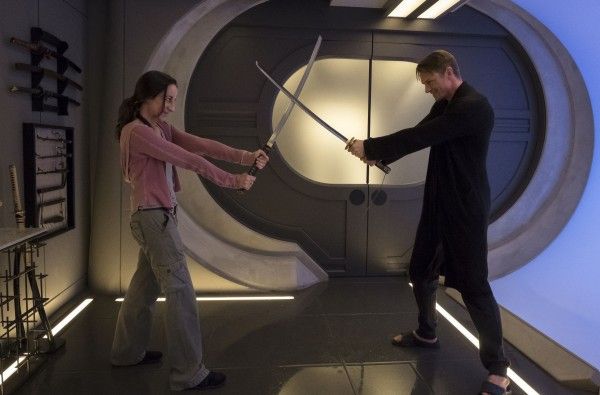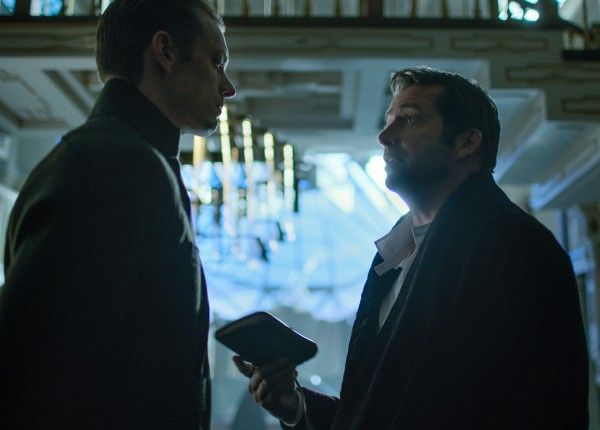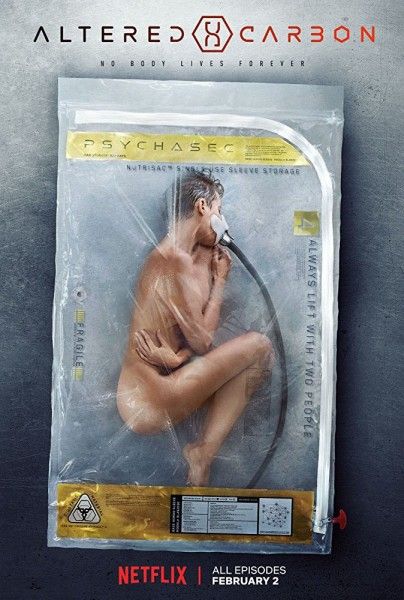Inspired by the acclaimed cyberpunk novel by Richard K. Morgan and created by Laeta Kalogridis, the Netflix series Altered Carbon follows Takeshi Kovacs (Joel Kinnaman), a 22nd century mercenary and rebel who has returned to life 300 years in the future, in order to find a killer. With his consciousness placed in a new body, or “sleeve,” that he’s not happy about being in, he must answer the question of what happened to the ultra-rich Laurens Bancroft (James Purefoy), along with whose body he was placed into, what’s become of the woman he loved, why he can’t get Lt. Kristin Ortega (Martha Higareda) off his back, and whether he can trust the military officer (Ato Essandoh) and AI entity called Poe (Chris Conner), who are helping him.
During this 1-on-1 phone interview with Collider, executive producer Laeta Kalogridis talked about why this story was best suited for a TV series, the biggest challenges in making this show, whether they had to cut anything for budget reasons, their hopes for Season 2, getting more women involved in the writers’ room and as directors, figuring out where to leave things, at the end of the season, and why it was important to dive into such dark themes. She also talked about what she’d like to see with the SAO (Sword Art Online) series that she’s setting up at Netflix, as well as her curiosity about Alita: Battle Angel (out in theaters in December), which she worked on, as a writer, in the early stages. Be aware that there are some spoilers discussed.
Collider: When it came to this book and this story, what made you see it as a TV series?
LAETA KALOGRIDIS: I tried writing it as a spec feature. It’s too dense to try to get all of the ideas across, in a two hour space. The range of my interests in science fiction, it really does run a gamut. There’s the inspiring stuff, like Black Panther and Wonder Woman, and then there’s the cautionary tales, like The Handmaid’s Tale and, I hope, like this, which exist better in a television format, for me. That idea of being able to explore what scares me about this particular emerging technology was very much more suited to the kinds of things that television is able to discuss, at this particular moment in time.
There are a lot of things happening on this show, with the characters and with the world. What were the biggest challenges in making this show?
KALOGRIDIS: It definitely was partially that, even at 10 hours, the book is dense. I also was very interested in expanding some of the themes and stories, and especially expanding the female characters that are in the book. That ended up making the story widened, so that it was more than just Kovacs’ journey. In so doing, it became a story that was longer, but also that was more multi-faceted and it included more perspectives beyond just his. I was able to explore where he came from, which the book has maybe two sentences about his previous sleeves and his life before he gets hired by Bancroft, other than the opening bit in the book. I was able to create this whole story for Will [Yun Lee] to play, and hire an Asian American actor to play the leading role and put him in Episodes 2, 3 and 4, and all of Episode 7. I definitely felt like the book could put you behind the eyes of the character, so you knew that he felt an essential sense of not being in his own body because, when given a choice, he picks Asian sleeves, so I really needed to establish the character and see the character as an Asian man. We hired three actors to do that – Byron Mann, Will Yun Lee and Morgan Gao, who plays him as a child.
Was there anything that you had to cut, as a result of the budget? Were there things you couldn’t do, or are you someone who just finds a way to do them?
KALOGRIDIS: The essential nature of all filmed entertainment is that you area always straddling the line of whether or not you can realize something that you want to do. I will say that the way that Netflix approached the story, which was totally letting creative lead, really allowed us to explore, visually, most everything that I wanted to be able to look at. And the fact that we found a really unusual stage in Vancouver helped. We found this building that was converted for the show, that used to house a printing press and was a printing facility. Because that stage unexpectedly had this huge long thing that used to hold the press, it was 450 feet long. You don’t usually get stages that are 450 feet long, so we could actually build the street indoors. It’s a really large set, and we were able to return to it, over and over again, as if it were an exterior location of a real street. It was a combination of finding an unusual venue that let us do things that we might not have otherwise been able to do and Netflix really believing in the vision of the show. Miguel Sapochnik did amazing work, as the pilot director, setting the look, and so did our DPs, Martin Ahlgren and Neville Kidd, our production designer, Carey Meyer, who was on Firefly, Angel and Buffy, and who’s really incredible, and our costume designer, Ann Foley, who was coming off of Agents of S.H.I.E.L.D. I look at the trooper costume designs that she made and they’re just really stunning. And our prop master, Nevin Swain, is ridiculous. I loved that gun! It was so much fun to redesign that. Part and parcel of any futuristic story like this is that you enjoy the toys, at least a little bit, and we did enjoy that part. I feel like we were trying to create a cohesive immersive world, and I feel that we did manage to do that.
It seems like you have to do a lot of pre-planning on a show like this. As far as the writers’ room goes, did you ever shut down, or did you immediately jump into coming up with ideas for Season 2?
KALOGRIDIS: We pulled so much stuff from the third book, by taking Quell and making her a contemporary of Kovacs’, which she isn’t in the original novels. She’s a couple hundred years before Kovacs, but I collapsed the timeline a little bit because I just wanted to see Quell. She was the reason I wanted to do it. I love Kovacs, and I fully admit that I let myself take this world and expand out the women because I love writing female characters. I love Ortega. In the book, she doesn’t have this whole extended family, or if she does, you never see it. I’m the granddaughter of immigrants, on my father’s side, so I wanted to recreate that kind of feeling. That’s why we hired someone who was very clearly an immigrant. Martha Higareda’s whole approach to the character, you don’t often get to see in science fiction, with that reflection of that experience. It’s like everything else, we don’t dwell on it, but we don’t ignore it. It’s woven into the world like a natural thing. So, the answer to the question you asked is, if there is a second season, it depends a whole lot of whether people like the first season. It’s going to be me and (author) Richard [K. Morgan] deciding, along with the writers’ room. Richard was on set and I consulted with him a lot. He’s quite a good friend now. It will be what we figure we should actually do with the ridiculous amount of mythology that he’s created. This is a complete universe that has extinct aliens, all sorts of bizarre tech, and really interesting political dynamics with the settled worlds and how they relate to each other as colonies. There’s just a huge amount of stuff, so it will really be a question of where we would want to focus. If we did do a second season, I think it would, without question, still be about Kovacs and his journey.
Would you also like to get more women involved, in the writers’ room and as directors?
KALOGRIDIS: Yes! Actually, I’m a huge believer in 50/50 by 2020. The writers’ room I have now is already 50/50, in terms of both gender and ethnicity. We have a very diverse writers’ room this year because it’s important to me to make sure that we pull from the same kind of different experiences that we’re trying to show on screen. We’re very diverse in front of the camera, and we want to be very diverse behind the camera, too. Uta [Briesewitz] was an amazing director, first season, and that’s absolutely the focus for a second season, if we get a second season, which we don’t know yet. I just never count on anything. You can’t. We just have to wait and see how it plays out. In the meantime, Richard and I will plot, and the writers’ room and I will plot, about what it would be really cool to get to do.
Was it a challenge to figure out where you wanted to leave things, at the end of the season?
KALOGRIDIS: For me, it was important, not knowing whether or not we’d be able to ever return to the universe, to create this hope for Kovacs. It’s a very noir ending. It’s freakin’ dark. I wanted to leave this moment where there’s some hope for him, and that if we did ever get to go forward in this story, we’d be able to explore that, but you would also feel like, if we weren’t able to move forward in a second season, the story was complete.
This is a cool show with cool visuals, but you also explore a lot of heavy themes, including victimization and exploitation. Why was that so important to you?
KALOGRIDIS: I look at my heroes in terms of writing and in terms of filmmaking, both large and small screen, and I was hugely influenced by the work of Ursula Le Guin and Margaret Atwood, and the work of Ray Bradbury and William Gibson, and they all used science fiction to deal very specifically with the intersections of race, gender and class through a futuristic lens, and usually one of disruptive technology or some kind of change in the way humanity lives. I was in love with The X-Men. It was so much of what everything I responded to had in common. My favorite Asimov works were the Foundation books because the concept, at the time, was crazy, but psycho-history has now turned out to be an actual real thing. You can predict the actions of large groups of people, once you understand, for lack of a better way to put it, their way of existing and their prejudices. There’s something fascinating about the concept of psycho-history as a disruptive technology, which is like understanding the world through crowd-sourcing, that gave rise to his version of what the future might look like, if you wanted to keep us from falling into 10,000 years of Dark Ages. Margaret Atwood, in the Maddaddam trilogy, was talking about what the future might look like, if we don’t stop doing what we’re doing to the planet. In The Handmaid’s Tale, she’s talking about what the future might look like, if we don’t stop specifically treating women the way that we treat women.
For me, there are two broad ways to look at the art that you make, if you’re trying to move the needle, even a little tiny bit, which I would like to do. One is the dystopic cautionary stuff, and that’s where this lives. For me, that’s what this show is about, which is why I wanted to dive into the very scary idea of class and the way that it will cause people to agree to do things that are incredibly terrible for them. The way that the married couple has normalized killing each other because that’s what they have to do to survive, or the hospital where the nurse says, “She doesn’t really have enough money, so sorry,” is a direct commentary, and I don’t know how much more direct I could get. The really terrible part with Quell is that she’s asking someone to kill her because she’s been lied to and she believes she will come back.
There’s a point of view, which is the dystopic point of view, that says, “I don’t know how to say how outraged I am without pointing to this.” There’s approximately 150 girls that Nassar appears to have abused. Nothing I can put on the screen comes close to Harvey [Weinstein], and I wrote this stuff before the reckoning. As a woman existing in this world, I am not confused and have never been confused about what’s happening. I’m not surprised. I have been asked occasionally, “Why would you put this up there?,” and the question isn’t, “Why am I putting it up there?,” the question is, “Why is it happening, and why aren’t we stopping it?” I’m trying to hold up a mirror. Nothing I imagine is worse than what’s actually happening, and that’s a terrible thing.
The other kind of art that attempts to move the needle for me is the stuff that’s aspirational and empowering, and that’s Wonder Woman and Black Panther. I tried to interweave very strong women who have agency into a very dark story because I don’t believe that one exists without the other. People key in on the fact that what we’re showing is very dark, but there’s also meant to be hope in there and empowered women doing powerful things, on both sides. The strongest characters in this show, both good and evil, are female. That’s really what it comes down to. As much as it is a dystopic vision, it has in it some very strong, very powerful women in roles that don’t necessarily co-exist as often as I would like, in this kind of fiction.
Along with Altered Carbon, you also sold SAO, or Sword Art Online, to Netflix. What would you like to see with the live-action English version of that popular Japanese novel and anime franchise? What do you think the best English version of that is?
KALOGRIDIS: Well, let’s get the obvious bit out of the way, right away. SAO is an essentially Japanese property, in which Kirito and Asuna, who are the two leads, are Japanese. In the television show, Kirito and Asuna will be played by Asian actors. Whether or not that was the question underneath your question, it’s not a conversation about whitewashing. When I sold it to Netflix, we were all on the same page. They are not interested in whitewashing it, and I am not interested in whitewashing it. In terms of the secondary characters, because the game is meant to be global, the way it’s presented in the anime and in the light novels, there are secondary characters that clearly are from other parts of the world, like Klein and Agil. To me, it’s very obvious when you watch it that you’re meant to take that this game spans the globe, but Kirito and Asuna are very clearly located as kids from Japan, and Tokyo, if I’m not mistaken. That is what we will be doing because that is the story. They are, in my mind anyway, much like Major Motoko Kusanagi in Ghost in the Shell, defined in part by being seminal characters in an Asian piece of art. That’s the first and biggest thing.
The second thing, in terms of what I would like to see for SAO, is that I feel it’s a much more aspirational story about hope and much less about darkness than Altered Carbon is. Asuna is sort of the savior of the world, in my mind and in the mind of the showrunners, [Patrick] Massett and [John] Zinman, who are doing the show. There’s a real ability to explore a fantasy-based The Lord of the Rings / Game of Thrones kind of world through the lens of these people who are trapped in it and don’t necessarily want to be there, but who have to learn how to survive in it. What I’m most interested in is all of the human stories, when everything else falls away and it’s life or death, in a place where you were never expecting to be trapped. That’s what I loved about the original anime and that’s what I love about the live-action adaptation, as we are currently envisioning it.
You also have Alita: Battle Angel coming out, which you worked as a writer on, in the early stages. What are you most excited about fans getting to see, with that film?
KALOGRIDIS: I did the script with Jim [Cameron], years and years ago. I haven’t been a part of the film, I wasn’t a part of the casting process, and I haven’t seen a cut. I liked the trailer. It’s an out-there choice for Robert Rodriguez. Speaking about the source material, it’s not really located specifically anywhere, so even though it’s a seminal piece of Japanese work, there is this very fascinating multi-cultural, multi-racial feel to the source material. When I look at the trailer, I’m like, “That’s pretty much what Ido looks like. Absent hair color, that’s pretty much what Chiren looks like. That’s pretty much what Zapan looks like. That’s definitely what Grewishka looks like, which is creepy as shit, with the arms that are made out of blades.” I haven’t seen a cut. I read the final shooting script, but all I can say is that I’m really excited to see it. I’m really curious to see what Robert did. I love that character. In Japanese, Gally is her name, and she’s Alita in English. I love her and I can’t wait to see her, but I don’t really know. I’m as curious as everybody else. Since it’s such a huge part of her identity, in the manga and the anime, that she’s meant to look like a doll, when Ido finds her in the scrapyard, the eyes are part of her design because she’s supposed to be able to get really close to you and disarm you by looking childlike, like that. I think it’s a fascinating choice to actually copy, almost exactly, what she looks like in the manga. I’m really, really curious. The whole thing is way cool, to be honest with you.
Altered Carbon is available to stream at Netflix.

